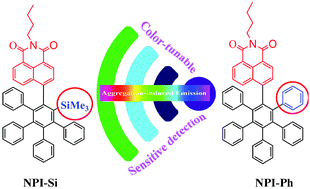Unexpected SiMe3 effect on color-tunable and fluorescent probes of dendritic polyphenyl naphthalimides with aggregation-induced emission enhancement†
Abstract
In this paper, two new organic dyes derived from 1,8-naphthalimide and dendritic polyphenyl were designed and synthesized. Both the dyes exhibited unique aggregation-enhanced emission enhancement properties in methanol/water mixtures. The traditional fluorescent materials 1,8-naphthalimides were successfully transformed to AIE-active materials based on the dendritic polyphenyl structure. Furthermore, NPI-Ph and NPI-Si displayed excellent optical properties, such as solvent-induced emission changes from deep blue to light green, and the sensitive fluorescence response to nitroaromatic explosives. Interestingly, an unexpected SiMe3 effect was found in the two dyes: the SiMe3-containing compound NPI-Si exhibited remarkably enhanced optical properties compared with the non-SiMe3 compound NPI-Ph such as a wider color-tunable range and higher sensitivity for the fluorescence detection of nitroaromatic explosives. The dendritic polyphenyl strategy and the SiMe3 effect reported in this work will provide guidance to the design of AIE-active molecules and fluorescent materials for detecting nitroaromatic explosives.


 Please wait while we load your content...
Please wait while we load your content...